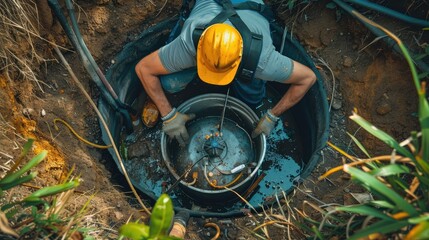Every time you flush your toilet, wash laundry or wash dishes wastewater flows down the sewer line toward your septic tank. The septic tank stores, treats and processes the wastewater before it’s dispersed to your drainfield.
Heavy solids sink to the bottom of the tank and undergo bacterial digestion. Oils and grease float to the top and form the “scum layer”. The clear liquid, called effluent, flows out from the septic tank outlet. Visit https://www.septictankarmadale.com.au/ to learn more.
A septic tank is used to collect, store and process all wastewater from the domestic household. That includes black water, or sewage, and grey water from kitchens, bathrooms and laundry. It doesn’t include rainwater from guttering and downpipes, which must drain to a separate drainage network that can be either a soakaway or a drainage field.
The wastewater is pumped from the tank into a drainage system, which can be a soakaway or a soil drainfield (also called an absorption field). The septic tank is buried underground and has a series of perforated pipes extending out into the soil to allow the pre-processed waste to drain into groundwater and watercourses.
During a new install, the tank can be installed in one of two ways:
In a single-dwelling household, a septic tank must have a capacity of at least 1,000 gallons. It should also have a large inspection opening and a manhole. It’s important to keep these access points protected and safe from children and unauthorized people. To do this, the lid of the tank should be secured with a lock or an approved safety device. The manhole is usually placed between six and 12 inches below the soil surface. To make access easier, it may be extended above the ground surface by a riser.
A 20-inch or larger square or round manhole should be installed over each compartment to provide access for agitation and cleaning. A riser should be placed over the opening to prevent accidental entry. Using a heavy metal or concrete cover helps to reduce the chance of tampering or theft.
Once the solid waste is settled in the septic tank, bacteria do their work to break down the organic material. This leaves the sludge at the bottom of the tank, while the scum rises to the top.
If the septic tank isn’t installed correctly, or it has a leak, problems can occur. Sewage can overflow into the surrounding area and expose people to disease-causing microorganisms. It’s important to get a professional to do the job right. A septic tank installation company will help you find the right system for your home and location, advise on where to place it, help with permits and explain different maintenance options.
Maintenance
A septic tank is one of the most critical yet overlooked functional elements of a property. Despite this, it is important for everyone to know what a septic system is, where it’s located and how to keep it in good working order.
Water that drains from sinks, toilets and other appliances is sent into the main drainage pipe that leads to your septic tank underground. Once there, the septic system is responsible for storing and processing all the black water (sewage) that is created in your home. Solids settle to the bottom of the tank and floaters such as oil and grease are separated from the liquid wastewater.
The liquid wastewater then flows into the drain field, a series of perforated pipes or slotted panels that are usually surrounded by gravel or a mixture of aggregate such as crushed bricks or tire chips. The drain field is a secondary treatment system that allows oxygen-using bacteria to deactivate any disease germs that remain in the sewage.
Over time, the septic system can be clogged by too much sludge and scum. When this occurs, the sewage may flow into the ground surface, where it exposes humans and animals to the disease germs that are found in sewage.
Fortunately, there are several things that you can do to avoid this problem. One is to only use cleaning products that are septic-safe, rather than those that contain chlorine or other chemicals. Instead, choose a natural product that won’t kill the beneficial waste-eating microorganisms in the septic system.
Another is to regularly have your septic tank pumped. The frequency with which this needs to be done depends on the size of your septic tank, the number of people living in your home and the type of waste that is generated. Ideally, it should be pumped every two to five years.
In addition to keeping up with regular maintenance, you can also protect your septic system by conserving water and landscaping carefully. For example, don’t place large plants or trees close to the treatment area. If you need to plant anything, be sure to choose a low-growing, native variety to minimize root invasion. Also, it’s important not to drive on or park vehicles over the treatment area.
Repairs
Many septic tank issues don’t cause any outward signs that something is wrong until the septic system fails. This is why septic tank inspections are so important. They help homeowners find and address septic tank problems early, which can save them a lot of money down the road.
When a septic tank fails, it can lead to untreated wastewater contaminating nearby water bodies. This poses a serious threat to aquatic life, ecosystem balance, and human health. The best way to prevent this is by maintaining septic tank and septic system maintenance routines, including regular pumping and inspections.
During a septic tank inspection, the technician will check the lids and openings for any cracks or other structural damage. They will also inspect the drain field, paying particular attention to wet areas in the yard.
They may use a camera to examine the interior of the tank. This allows them to see what is in the septic tank without having to enter it, which can be dangerous. They will also check for the scum and sludge layers. When the septic tank is not pumped regularly, these layers get thicker, and solid waste floats out of the tank and into the drain field or leach line. This causes the drain field to clog and eventually fail.
It is also possible that the septic tank will need to be replaced. This is a very expensive repair, so it is essential to schedule pumping and inspections regularly.
Septic tanks can last for up to 40 years if well maintained, but without proper care, they can start failing within ten or fifteen years.
If your toilets, sinks, or tubs are clogged, it is likely because of a septic tank problem. Unpleasant odors around the house or in the yard may also indicate that the septic tank is failing. A failed septic tank can also be a fire hazard and pose a health risk. When you notice these signs, call for emergency septic tank service right away. They will pump out the septic tank and jet out the drain field if necessary to clean it out. They will leave you with a septic tank inspection report and letter, which must be submitted to the health department in order to obtain a permit for repairs.
Replacement
If your septic system is starting to fail, you may need to consider replacing it. However, you will want to be sure you choose the right type of septic system for your property. A professional septic service provider can assist you in determining whether restoration or replacement is the best option for your home or business.
The main function of your septic tank is to treat wastewater and sewage. The solids in your septic tank sink to the bottom of the tank and undergo bacterial digestion to break them down into sludge. The liquid part of the wastewater, known as effluent, then flows into your septic drain field to soak into the soil where it undergoes further filtration and treatment.
A properly functioning septic system will help to protect your water quality and reduce the risk of disease-causing germs getting into the groundwater supply. If you are experiencing problems with your septic system, it is important to act quickly. The sooner you call for a septic tank replacement, the less likely you are to have more expensive repairs in the future.
Some signs that you may need a new septic system include constant overflow or a high level of solids in the septic tank. Overflowing septic systems indicate that the tank isn’t disposing of the waste appropriately, and a high solid level indicates the tank is clogged.
Clogged septic tanks can also cause sewage to back up into the plumbing fixtures in your home. This is a clear indication that something is wrong with your septic system and needs immediate attention. Keeping your septic tank free of solids is essential, and the best way to do this is to avoid flushing anything other than human waste and white toilet paper. Many products that are advertised as ‘flushable’ can actually clog your pipes.
If your septic tank is overflowing, it will need to be cleaned by a licensed septic service company. When this is done, the solids will be removed from the tank and transported to a landfill where they will be disposed of in a sanitary manner.

